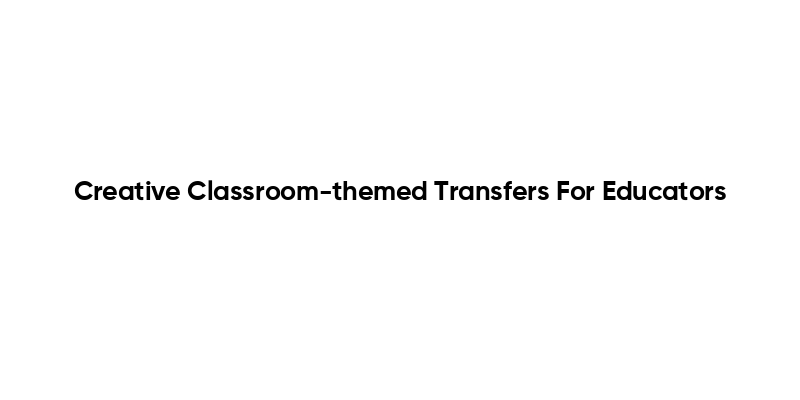In today’s dynamic educational landscape, Creative Classroom-themed Transfers for Educators have emerged as a vital tool for enhancing teaching methodologies and fostering student engagement. These innovative strategies not only enrich the learning experience but also empower educators to create a more interactive and stimulating classroom environment. By integrating creative transfers, teachers can effectively bridge the gap between traditional teaching methods and modern educational needs, ensuring that students remain motivated and inspired throughout their learning journey.
As you delve deeper into this article, you will discover a variety of practical techniques and resources designed to implement Creative Classroom-themed Transfers in your teaching practice. From hands-on activities that promote collaboration to digital tools that facilitate interactive learning, we will explore how these transfers can transform your classroom dynamics. Additionally, we will discuss the importance of adaptability in teaching and how these creative approaches can cater to diverse learning styles, ensuring that every student has the opportunity to thrive.
Stay with us as we unpack the essential elements of Creative Classroom-themed Transfers for Educators. Whether you are a seasoned teacher looking to refresh your approach or a new educator eager to make a lasting impact, this article will provide you with valuable insights and actionable strategies. Join us on this journey to revolutionize your teaching methods and create a vibrant learning atmosphere that captivates and inspires your students!
The Importance of Thematic Learning in Education
Thematic learning is an educational approach that integrates various subjects around a central theme. This method not only enhances student engagement but also promotes critical thinking and problem-solving skills. By focusing on a specific theme, educators can create a more cohesive learning experience that connects different disciplines, making the content more relevant and relatable to students.
In a creative classroom, thematic learning can be particularly effective. For instance, a theme like “Sustainability” can encompass science, social studies, and art, allowing students to explore the topic from multiple perspectives. This interdisciplinary approach fosters a deeper understanding and encourages students to make connections between their learning and the real world.
Innovative Classroom Decor Ideas for Thematic Transfers
Classroom decor plays a crucial role in setting the tone for thematic learning. Creative decorations can transform a standard classroom into an immersive environment that reflects the chosen theme. For example, if the theme is “Space Exploration,” educators can use glow-in-the-dark stars, planet models, and space-themed bulletin boards to create an engaging atmosphere.
Additionally, incorporating student artwork related to the theme can personalize the space and encourage ownership of the learning environment. By allowing students to contribute to the decor, educators can foster a sense of community and collaboration, which is essential for effective learning.
Engaging Activities for Thematic Learning
To maximize the benefits of thematic learning, educators should incorporate a variety of engaging activities that cater to different learning styles. Hands-on projects, group discussions, and interactive games can all be effective ways to reinforce the theme. For instance, a “Cultural Diversity” theme could include cooking sessions, storytelling, and art projects that celebrate various cultures.
Moreover, integrating technology into these activities can enhance student engagement. Virtual field trips, online research projects, and multimedia presentations can provide students with diverse ways to explore the theme, making learning more dynamic and interactive.
Assessment Strategies for Thematic Units
Assessing student learning in thematic units can be challenging, but it is essential for measuring understanding and progress. Educators can use a variety of assessment strategies, including project-based assessments, peer evaluations, and reflective journals. These methods allow students to demonstrate their knowledge in creative ways, rather than relying solely on traditional tests.
Additionally, formative assessments throughout the unit can help educators gauge student understanding and adjust instruction as needed. By providing ongoing feedback, educators can support student growth and ensure that all learners are engaged and challenged.
Collaborating with Parents and the Community
Engaging parents and the community in thematic learning can enhance the educational experience for students. Educators can invite parents to participate in classroom activities, share their expertise, or contribute resources related to the theme. This collaboration not only enriches the learning environment but also strengthens the connection between school and home.
Furthermore, community partnerships can provide valuable opportunities for students to apply their learning in real-world contexts. Field trips, guest speakers, and service projects can all be integrated into thematic units, allowing students to see the relevance of their education beyond the classroom.
| Transfer Type | Description | Benefits |
|---|---|---|
| Visual Aids | Utilizing posters, charts, and infographics to enhance learning. | Improves retention and understanding of complex concepts. |
| Interactive Activities | Incorporating games and hands-on projects to engage students. | Encourages collaboration and critical thinking skills. |
| Technology Integration | Using digital tools and platforms for assignments and presentations. | Prepares students for a tech-driven world and enhances digital literacy. |
| Storytelling Techniques | Employing narratives to make lessons relatable and memorable. | Fosters creativity and emotional connection to the material. |
| Peer Teaching | Encouraging students to teach each other under guidance. | Builds confidence and reinforces knowledge through teaching. |
| Flexible Seating | Creating a dynamic classroom layout that promotes comfort and collaboration. | Enhances focus and allows for varied learning styles. |
| Mindfulness Practices | Incorporating mindfulness exercises to improve focus and reduce stress. | Promotes mental well-being and a positive classroom environment. |



